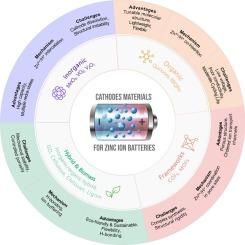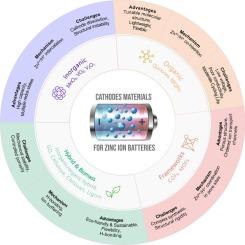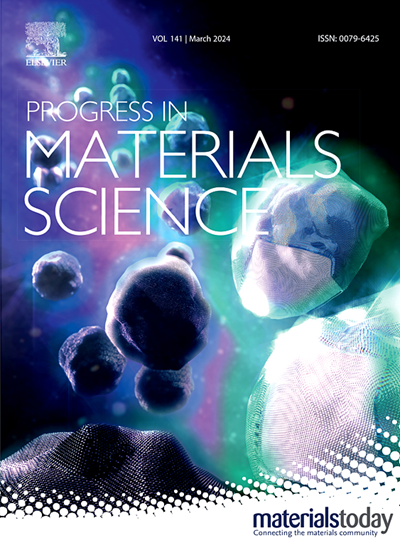可充电锌离子电池正极材料的进展:从无机和有机系统到混合框架和生物质衍生的创新
IF 40
1区 材料科学
Q1 MATERIALS SCIENCE, MULTIDISCIPLINARY
引用次数: 0
摘要
锌离子电池(zib)由于其低成本、环境友好和固有的安全性而成为大规模储能系统的有前途的候选材料,并已成为学术研究和产业发展战略的重点。然而,在取得有意义的进展之前,必须解决重大挑战,例如次优电荷动力学,电极结构稳定性不足以及复杂且昂贵的制造方法。在此基础上,本文从影响电极材料电化学性能的基本因素(如电导率、离子扩散途径、结构稳定性、氧化还原活性和表面/界面特性)开始,对电极材料进行了全面的综述。清楚地了解这些参数对于指导zib高性能电极的合理设计和优化至关重要。其次,我们批判性地评估当前的进展,确定持续的局限性,并探索潜在的策略来克服实现长期循环稳定性和快速反应动力学的挑战。详细分析了不同材料系统的结构工程方法、电化学行为和锌离子储存机制,为推动下一代AZB开发的设计原则提供了深入的见解。最后,我们还通过确定关键挑战和有希望的机会,对ZIBs的未来发展进行了全面展望,以推动它们在该领域的快速进展和广泛的实际部署。本文章由计算机程序翻译,如有差异,请以英文原文为准。


Progress in cathode materials for rechargeable Zinc-Ion batteries: from inorganic and organic systems to hybrid frameworks and biomass-derived innovations
Zinc-ion batteries (ZIBs) have gained significant attention as promising candidates for large-scale energy storage systems owing to their low cost, environmental friendliness, and inherent safety, and have become a key focus of both academic research and industrial development strategies. However, significant challenges must be resolved, such as suboptimal charge kinetics, inadequate electrode structural stability, and complicated and costly manufacturing methods, prior to achieving meaningful advancements. Building on this foundation, this review offers a comprehensive overview of electrode materials, beginning with the fundamental factors that influence their electrochemical performance, such as electronic conductivity, ion diffusion pathways, structural stability, redox activity, and surface/interface characteristics. A clear understanding of these parameters is essential for guiding the rational design and optimization of high-performance electrodes for ZIBs. Secondly, we critically assess the current progress, identify persistent limitations, and explore potential strategies to overcome the challenges in achieving long-term cycling stability and fast reaction kinetics. Detailed analyses of structural engineering approaches, electrochemical behavior, and zinc-ion storage mechanisms across diverse material systems are presented to provide deep insights into the design principles driving next-generation AZB development. Finally, we also included a comprehensive outlook on the future development of ZIBs by identifying critical challenges and promising opportunities to drive their rapid progress and extensive practical deployment in the field.
求助全文
通过发布文献求助,成功后即可免费获取论文全文。
去求助
来源期刊

Progress in Materials Science
工程技术-材料科学:综合
CiteScore
59.60
自引率
0.80%
发文量
101
审稿时长
11.4 months
期刊介绍:
Progress in Materials Science is a journal that publishes authoritative and critical reviews of recent advances in the science of materials. The focus of the journal is on the fundamental aspects of materials science, particularly those concerning microstructure and nanostructure and their relationship to properties. Emphasis is also placed on the thermodynamics, kinetics, mechanisms, and modeling of processes within materials, as well as the understanding of material properties in engineering and other applications.
The journal welcomes reviews from authors who are active leaders in the field of materials science and have a strong scientific track record. Materials of interest include metallic, ceramic, polymeric, biological, medical, and composite materials in all forms.
Manuscripts submitted to Progress in Materials Science are generally longer than those found in other research journals. While the focus is on invited reviews, interested authors may submit a proposal for consideration. Non-invited manuscripts are required to be preceded by the submission of a proposal. Authors publishing in Progress in Materials Science have the option to publish their research via subscription or open access. Open access publication requires the author or research funder to meet a publication fee (APC).
Abstracting and indexing services for Progress in Materials Science include Current Contents, Science Citation Index Expanded, Materials Science Citation Index, Chemical Abstracts, Engineering Index, INSPEC, and Scopus.
 求助内容:
求助内容: 应助结果提醒方式:
应助结果提醒方式:


